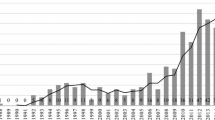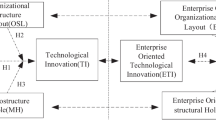Abstract
The current study investigates parts manufacturers’ innovative behavior from the population ecology perspective. Specifically, this paper proposes that firm level inertia and network level inertia matter in parts manufacturer’s innovation. Using data from auto parts manufacturers, we test four hypotheses, and the results show that firm level inertia indicated by age does not matter, while firm’s innovative inertia matters in parts manufacturers’ innovation. At the same time, we find that cluster can promote general parts firms’ innovation, but they will harm the innovative firms’ innovative behavior. These results contribute to our understanding of parts manufacturer’s innovation.

Similar content being viewed by others
References
Chandrashekaran, M., Mehta, R., Chandrashekaran, R., & Grewal, R. (1999). Market motives, distinctive capabilities, and domestic inertia: A hybrid model of innovation generation. Journal of Marketing Research, 52, 95–112.
Choi, S. B., Lee, S. H., & Williams, C. (2011). Ownership and firm innovation in a transition economy: Evidence from China. Research Policy, 40, 441–452.
Cohen, W. M., & Levinthal, D. A. (1990). Absorptive capacity: a new perspective on learning and innovation. Administrative Science Quarterly, 1, 128–152.
Eisenhardt, K. M., & Martin, J. A. (2000). Dynamic capabilities: What are they? Strategic Management Journal, 21(10–11), 1105–1121.
Filatotchev, I., Liu, X., Lu, J., & Wright, M. (2011). Knowledge spillovers through human mobility across national borders: Evidence from Zhongguancun Science Park in China. Research Policy, 40, 453–462.
Flyer, F., & Shaver, J. M. (2003). Location choices under agglomeration externalities and strategic interaction. Advances in Strategic Management, 20, 193–213.
Genus, A. & Jha, P. (2012). The role of inertia in explanations of project performance: a framework and evidence from project-based organizations. International Journal of Project Management, 30, 117–126.
Gilbert, C. G. (2005). Unbundling the structure of inertia: Resource versus routine rigidity. Academy of Management Journal, 5, 741–763.
Greve, H. R. (1998). Performance, aspirations, and risky organizational change. Administrative Science Quarterly, 44, 55–86.
Greve, H. R. (2003). A behavioral theory of R&D expenditures and innovation: Evidence from shipbuilding. Academy of Management Journal, 46, 685–702.
Hannan, M. T. (2005). Ecologies of organizations: Diversity and identity. Journal of Economic Perspectives, 1, 51–70.
Hannan, M. T., & Freeman, J. (1977). The population ecology of organizations. American Journal of Sociology, 5, 929–964.
Hannan, M. T., & Freeman, J. (1984). Structural inertia and organizational change. American Sociological Review, 2, 149–164.
Henderson, R. M., & Clark, K. B. (1990). Architectural innovation: The reconfiguration of existing product technologies and the failure of established firms. Administrative Science Quarterly, 35, 9–30.
Hu, A. G. (2010). Propensity to patent, competition and China’s foreign patenting surge. Research Policy, 39, 985–993.
Hu, A. G., & Jefferson, G. H. (2009). A great wall of patents: What is behind China’s recent patent explosion? Journal of Development Economics, 90, 57–68.
Huff, J. O., Huff, A. S., & Thomas, H. (1992). Strategic renewal and the interaction of cumulative stress and inertia. Strategic Management Journal, 13, 55–75.
Kim, T., Oh, H., & Swaminathan, A. (2006). Framing interorganizational network change: A network inertia perspective. Academy of Management Review, 31, 704–720.
Levinthal, D. (1992). Surviving Schumpeterian environments: An evolutionary perspective. Industrial and Corporate Change, 1, 427–443.
Liao, S., Fei, W., & Liu, C. (2008). Relationships between knowledge inertia, organizational learning and organization innovation. Technovation, 28, 183–195.
March, J. G. (1991). Exploration and exploitation in organizational learning. Organization Science, 2, 71–87.
March, J. G., & Simon, H. A. (1958). Organizations. New York: Wiley.
Marshall, A. (1920). Principles of economics (8th ed.). Macmillan: London.
Mokyr, J. (1992). Technological inertia in economic history. Journal of Economic History, 52, 325–338.
Narula, R. (2002). Innovation systems and ‘inertia’ in R&D location: Norwegian firms and the role of systemic lock-in. Research Policy, 31, 795–816.
Porter, M. E. (2000). Location, competition and economic development: Local clusters in a global economy. Economic Development Quarterly, 14(1), 15–34.
Schreyogg, G., & Kliesch-Eberl, M. (2007). How dynamic can organizational capabilities be? Towards a dual-process model of capability dynamization. Strategic Management Journal, 28, 913–933.
Sun, Y. (2003). Determinants of foreign patents in China. World Patent Information, 25, 27–37.
Tallman, S., Jenkins, M., Henry, N., & Pinch, S. (2004). Knowledge, clusters, and competitive advantage. Academy of Management Review, 29(2), 258–271.
Tushman, M. L., & Anderson, P. (1986). Technological discontinuities and organizational environments. Administrative Science Quarterly, 3, 439–465.
Tushman, M. L., & O’Reilly, C. (1996). Ambidextrous or organizations: Managing evolutionary and revolutionary change. California Management Review, 38, 8–30.
Acknowledgments
The paper is a stage result of the project of Financial support from National Natural Science Foundation of China (No. 71172184 and No. 70872088) and is also supported by the Specialized Research Fund for the Doctoral Program of Higher Education (No. 20100201110064). The authors are grateful to the Editor and the anonymous reviewers for their helpful comments, suggestions and help.
Author information
Authors and Affiliations
Corresponding author
Rights and permissions
About this article
Cite this article
Wu, S., Huang, Z. & Zhong, W. Does inertia matter for parts manufacturers’ innovation?. Scientometrics 101, 705–716 (2014). https://doi.org/10.1007/s11192-013-1191-5
Received:
Published:
Issue Date:
DOI: https://doi.org/10.1007/s11192-013-1191-5




